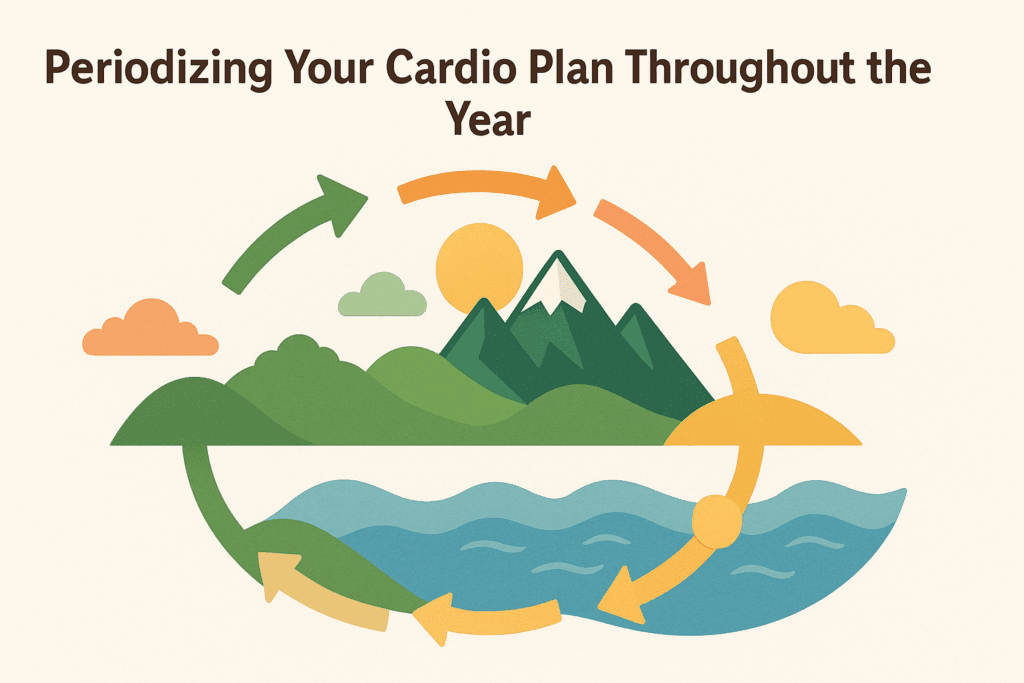Unlocking the Power of Cardio for Runners
For runners, cardio isn’t just a part of the training equation—it’s the foundation. Cardiovascular endurance is what allows runners to go the distance, maintain a steady pace, and recover faster between efforts. Whether you’re a casual jogger or a competitive athlete, integrating the right cardio strategies into your routine can elevate your performance and safeguard your health.
Cardio for runners serves multiple purposes beyond simply increasing mileage. It enhances oxygen delivery to muscles, builds aerobic capacity, and conditions the heart to handle longer, harder efforts with greater ease. When approached strategically, a cardio run can transform how efficiently your body operates during both short bursts and extended runs.
Many runners mistakenly equate cardio with monotony, believing it to be endless miles on the road at the same pace. But in reality, a well-crafted cardio run routine incorporates diverse elements—from low-intensity recovery jogs to high-powered intervals—all working synergistically to improve stamina, power, and efficiency. Understanding the physiology behind cardio training is the first step in mastering its potential.
You may also like: Smart Nutrition Choices for a Healthier Lifestyle: What to Know About Whole Grain Rice and Whole Wheat Rice

Understanding Aerobic and Anaerobic Systems
Cardiovascular exercise works through two primary systems: aerobic and anaerobic. Each plays a unique role in supporting endurance and speed. Aerobic exercise uses oxygen to generate energy, fueling long and steady efforts. Anaerobic training, by contrast, involves high-intensity output over shorter periods, where the body relies more on stored energy than oxygen.
When designing cardio for runners, it’s crucial to train both systems to build a comprehensive endurance base and top-end speed. Aerobic running develops efficiency, enabling runners to cover long distances with minimal fatigue. Anaerobic training increases the body’s tolerance for lactic acid buildup, making runners faster and more resilient during high-effort races or sprints.
Balancing the two systems within a periodized training plan ensures that each run serves a purpose. Rather than randomly alternating between speeds, runners should strategically apply aerobic and anaerobic principles to different days and distances, giving the body time to adapt and grow stronger over time.

Structuring a Weekly Cardio Run Plan for Peak Performance
Creating a weekly cardio run plan is about much more than filling a calendar with miles. A smart schedule aligns with your current fitness level, goals, and available time while incorporating progressive overload and recovery. Variety is key to ensuring cardiovascular adaptations and preventing burnout or injury.
A balanced week might include a long run to build aerobic base, a tempo run to improve lactate threshold, and an interval session to spike VO2 max. Each session challenges the heart differently, expanding its capacity over time. Recovery runs, done at a conversational pace, promote active healing while still stimulating the cardiovascular system gently.
Consistency over weeks and months leads to significant gains in endurance and race readiness. This is where cardio for runners becomes more than a habit—it becomes a strategic tool for unlocking potential and achieving tangible results.

Cross-Training for Cardiovascular Balance and Injury Prevention
While running provides excellent cardiovascular conditioning, it also places repetitive stress on the body. Cross-training offers a valuable alternative that protects joints and muscles while still stimulating the heart and lungs. It’s an essential part of a sustainable cardio strategy, especially for runners prone to overuse injuries.
Low-impact cardio exercises like cycling, swimming, rowing, or elliptical workouts are ideal complements to a running regimen. These activities engage different muscle groups and offer a refreshing change of pace, mentally and physically. Cross-training also allows runners to increase total training volume without additional impact stress.
By incorporating cross-training one to two times a week, runners can continue building cardiovascular strength on non-running days. This flexibility ensures continuous improvement and can help runners maintain peak condition during injury recovery or taper phases.

Using Heart Rate Zones for Smarter Training
Heart rate monitoring offers a scientific lens through which runners can gauge intensity and maximize each workout’s benefit. The body responds differently to training stimuli depending on the heart rate zone in which it’s operating. Tailoring runs to target specific zones ensures that workouts are both effective and efficient.
For most cardio run sessions aimed at building base endurance, Zone 2 training (around 60–70% of max heart rate) is optimal. It improves fat metabolism and aerobic efficiency. Zone 3 and 4 runs—like tempo sessions—train the body to manage and clear lactate more effectively. Short bursts into Zone 5 during sprints or intervals enhance peak cardiovascular capacity and neuromuscular coordination.
Understanding and applying heart rate zones transforms cardio for runners into a precision-based discipline. It eliminates guesswork, prevents overtraining, and enhances performance with targeted consistency.

Interval Training: The Secret Weapon for Breaking Plateaus
Interval training—repeated cycles of high effort followed by recovery—is a proven method to boost endurance and speed. These sessions force the cardiovascular system to adapt to extremes, increasing stroke volume, VO2 max, and overall heart strength.
A typical interval session might include 400m or 800m repeats at race pace or faster, with equal or slightly longer recovery jogs. These workouts not only improve cardiovascular function but also teach runners to manage effort and recover efficiently. The cumulative benefits are enhanced muscular endurance, improved lactate tolerance, and faster race times.
When incorporated once or twice per week, interval training can help runners break through plateaus, turning cardio run sessions into high-yield investments in fitness and confidence.
Prioritizing Recovery for Long-Term Gains
No matter how well-designed a training program is, without recovery, it cannot succeed. Recovery is when the body repairs tissue, adapts to stress, and prepares for the next effort. Ignoring it leads to fatigue, diminished returns, and potential injury.
Active recovery days, where cardio effort is kept light and low-intensity, promote circulation and help the heart maintain its conditioning without overstress. Sleep, hydration, and nutrition play supporting roles in this process, facilitating muscle repair and hormone regulation.
For cardio for runners to yield lasting results, recovery must be integrated as intentionally as workouts. Recovery is not a pause from progress—it is the foundation on which new performance is built.
Nutrition That Fuels Cardio Success
Cardiovascular performance depends not only on physical effort but also on fuel. The body draws from carbohydrate, fat, and protein stores to power various types of workouts. Pre-run meals should emphasize complex carbs for energy, while longer efforts may require intra-run fueling with gels or drinks.
Post-run nutrition is essential for recovery. A balanced meal rich in carbohydrates and protein replenishes glycogen and supports muscle repair. Electrolytes—lost through sweat—must also be replaced to maintain fluid balance and heart rhythm efficiency.
When aligned with training goals, nutrition becomes a performance enhancer. Runners who tailor their diets to their cardio demands report fewer crashes, faster recovery, and better race outcomes.
Mental Fortitude: The Unseen Driver of Endurance
Running is as much a mental game as a physical one. When legs get tired and breath shortens, it’s mental strength that carries runners forward. Building resilience requires consistent practice, just like physical training.
Visualization techniques, where runners mentally rehearse races or challenging sessions, enhance focus and confidence. Positive self-talk, especially during hard efforts, counteracts fatigue-induced doubt. Setting meaningful goals—both big and small—creates motivation that endures even on tough days.
Developing a mental strategy makes every cardio run not just an exercise in stamina, but in self-mastery. When mind and body work in harmony, performance soars.

Periodizing Your Cardio Plan Throughout the Year
Effective training isn’t linear—it follows a wave of stress, adaptation, and recovery. Periodization involves structuring training phases (base, build, peak, taper, recovery) to align with performance goals and prevent stagnation.
During base phases, runners focus on building aerobic endurance with steady, moderate runs. Build phases introduce intensity and specificity, sharpening fitness. Taper phases reduce volume to allow peak performance. Recovery phases help reset the system before the next cycle.
Cardio for runners must evolve with these cycles. By periodizing training, runners reduce injury risk and arrive at races physically fresh and mentally primed to perform.
Leveraging Tech and Wearables to Track Progress
Today’s runners have access to powerful tools that can enhance training insights. GPS watches track pace and distance, while heart rate monitors provide real-time feedback on effort. Apps analyze data to recommend future workouts or flag signs of fatigue.
Advanced tools such as lactate threshold testing or VO2 max assessments offer elite-level insights. Even running form apps can highlight biomechanical inefficiencies that affect cardiovascular output.
Technology used wisely empowers runners to train with precision, track progress meaningfully, and adjust plans based on real-world feedback.
Adapting Cardio Strategies for Masters Runners
As we age, cardiovascular function changes. Maximum heart rate declines, recovery slows, and muscle mass shrinks. Yet with intelligent training, older runners can maintain impressive fitness and continue setting goals.
Emphasizing quality over quantity becomes more important. Shorter, more frequent workouts may be preferable to long sessions. Strength training helps offset muscle loss, while joint-friendly cardio options like pool running or elliptical sessions reduce impact.
Cardio for runners over 50 isn’t about slowing down—it’s about training smarter. A well-adjusted plan can extend peak performance for years to come.
Environmental Factors That Influence Cardio Efficiency
Running conditions matter. Heat, humidity, elevation, and terrain all affect cardiovascular load. Running in heat elevates heart rate and can reduce performance, while altitude forces the heart to work harder in thinner air.
Adjusting pace expectations for environmental stressors ensures safer, more effective training. Hydration, pacing, and clothing choices become essential tools in managing these external factors.
By preparing for the environmental variables that influence cardio run sessions, runners can train more intelligently and stay consistent regardless of location or season.
Sleep: The Missing Piece in Cardiovascular Adaptation
High-quality sleep is a performance multiplier. During sleep, the body repairs muscle tissue, balances hormones, and consolidates motor learning. Sleep deprivation, on the other hand, raises cortisol, weakens immunity, and reduces cardiovascular efficiency.
Runners should aim for at least seven to nine hours of quality sleep, especially during high-volume training weeks. Sleep hygiene practices—consistent bedtimes, screen reduction, and calming rituals—can enhance sleep quality.
For cardio for runners to reach its full potential, sleep must be seen as non-negotiable recovery—not an afterthought.
Frequently Asked Questions: Advanced Insights on Cardio Training for Runners
1. How can runners use heart rate zones to optimize their cardio training?
Understanding heart rate zones is essential for fine-tuning cardio for runners. By training in Zone 2 (roughly 60–70% of your max heart rate), runners can build aerobic endurance without overtraining. Conversely, incorporating intervals in Zones 4 and 5 enhances speed and lactate threshold—crucial for competitive runners. Many runners mistakenly spend too much time in moderate zones, which can lead to stagnation. A well-balanced cardio run plan cycles through all heart rate zones strategically to avoid burnout and encourage physiological adaptation.
2. What role does mental conditioning play in long-term cardio success for runners?
Mental endurance is a frequently overlooked element of cardio for runners. Techniques like visualization, mindfulness, and even cognitive reframing can improve focus during a demanding cardio run. Elite runners often train their minds to stay calm under physical stress, which translates into more consistent pacing and better recovery. Studies in sports psychology show that mental fatigue can impair performance even when the body is physiologically capable. Investing in mental training is just as important as interval workouts for reaching new running milestones.
3. Is there an optimal time of day for runners to perform cardio sessions?
While individual preference matters, research suggests that morning cardio for runners may offer slight metabolic and psychological advantages. Morning sessions help establish a routine and can improve consistency, while late-afternoon cardio runs may benefit from higher body temperature and muscle flexibility. The key is aligning your cardio run with your circadian rhythm and daily stress patterns. Runners with demanding jobs might find evening cardio decompresses mental tension and improves sleep quality, which is vital for recovery.
4. How does terrain variation affect the benefits of cardio for runners?
Switching up terrain during a cardio run can significantly amplify fitness gains. Hills build strength and power, while trail running improves proprioception and engages stabilizing muscles. Urban environments are great for speed training, but varied terrain challenges your cardiovascular system differently, helping to avoid plateaus. A well-rounded approach to cardio for runners should include at least one weekly session on an unfamiliar surface to keep both body and mind engaged. This diversity also reduces repetitive strain injuries common in single-surface runners.
5. What are the latest innovations in wearables for runners doing cardio?
Advanced wearables now offer real-time biometrics like VO2 max estimation, lactate threshold tracking, and stride dynamics—all of which are game-changers in tailoring cardio for runners. Devices like Garmin and Coros even recommend personalized recovery windows based on HRV (heart rate variability). These technologies allow a cardio run to be adjusted mid-session, optimizing training load in real time. As algorithms grow more precise, runners can anticipate fatigue or overtraining before symptoms appear. This proactive approach supports smarter, safer endurance building.
6. Can strength training enhance cardio performance for runners?
Absolutely. Integrating strength training two to three times per week greatly benefits cardio for runners by improving joint stability, muscle power, and running economy. A stronger core helps maintain form during a long cardio run, while improved muscle balance reduces injury risk. Functional movements like deadlifts, Bulgarian split squats, and planks are particularly effective. Contrary to outdated beliefs, strength training doesn’t bulk runners—it refines their stride and reduces energy leaks. This hybrid approach is increasingly popular among top-tier endurance athletes.
7. How can nutrition before and after a cardio run enhance results?
Tailored nutrition is crucial for optimizing performance and recovery in cardio for runners. Pre-run meals should include easily digestible carbs and a bit of protein to sustain energy without causing gastrointestinal distress. Post-cardio run nutrition must replenish glycogen stores and repair muscle tissue—ideally with a 3:1 ratio of carbs to protein. Hydration is equally critical, especially for longer sessions. Nutrient timing—known as the “anabolic window”—can accelerate muscle repair and reduce soreness, making it easier to stick with high-frequency training schedules.
8. How does cross-training support cardiovascular performance in runners?
Cycling, swimming, rowing, and even hiking are excellent cross-training choices that support cardio for runners by reducing impact while preserving aerobic conditioning. Incorporating a non-running cardio run alternative once or twice a week can extend an athlete’s training lifespan. It also mitigates overuse injuries, particularly in runners prone to shin splints or plantar fasciitis. Cross-training keeps workouts mentally refreshing and can target muscle groups that aren’t activated in traditional running. This well-rounded strategy enhances performance while minimizing the risk of burnout.
9. What psychological strategies can help maintain long-term motivation for cardio?
Sustainable motivation is a critical element of success with cardio for runners. Setting process-based goals (like weekly mileage or time spent in target heart zones) rather than outcome goals fosters a growth mindset. Tracking small wins after each cardio run, such as improved pace or lower perceived exertion, reinforces progress. Joining a running community or online challenge introduces social accountability. Some runners benefit from “gamifying” workouts with apps that unlock achievements or offer virtual races. These psychological tactics cultivate long-term engagement.
10. What does the future of cardio training for runners look like?
Emerging trends suggest a tech-integrated and more individualized future for cardio for runners. AI coaching platforms now analyze thousands of biometrics and adjust plans daily, offering hyper-personalized cardio run prescriptions. Virtual reality and immersive treadmills may transform indoor running into multisensory endurance simulations. Additionally, advancements in sports genomics could reveal how your unique DNA influences aerobic potential, recovery speed, and injury susceptibility. As science continues to evolve, the next decade will empower runners to train smarter—not just harder.
Conclusion: Redefining Your Cardio Run Strategy for Peak Endurance and Performance
A powerful cardio run strategy is more than just a schedule of workouts—it’s a comprehensive approach that integrates physiology, nutrition, mindset, and lifestyle into a seamless performance system. By understanding how aerobic and anaerobic systems work together, tailoring weekly plans, using tools like heart rate zones, and respecting the body’s need for recovery, runners can unlock new levels of stamina and speed.
Cardio for runners is a dynamic pursuit. It evolves with experience, adapts to life’s changing demands, and responds best to consistency, not perfection. The most successful runners aren’t those who push the hardest, but those who train the smartest—balancing effort with rest, data with intuition, and ambition with patience.
As you continue your running journey, use these expert strategies to elevate every step. Let each cardio run serve as both a physical challenge and a celebration of what your body can achieve. With the right approach, running becomes not just a workout, but a lifelong expression of endurance, performance, and well-being.
Was this article helpful? Don’t let it stop with you. Share it right now with someone who needs to see it—whether it’s a friend, a colleague, or your whole network. And if staying ahead on this topic matters to you, subscribe to this publication for the most up-to-date information. You’ll get the latest insights delivered straight to you—no searching, no missing out.
Further Reading:
13 Ways to Increase Your Running Stamina

